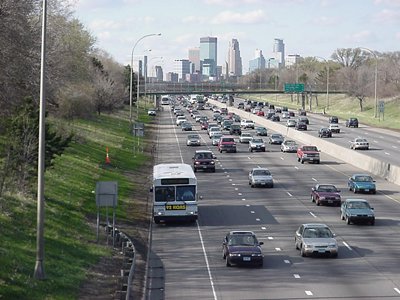More express and local transit buses that operate on the region's highways could eventually, in select locations and under certain traffic conditions, be allowed to use shoulders to bypass especially bad congestion in regular travel lanes if a new task force set up by the Transportation Planning Board finds that it would be safe, practical, and advantageous to do so.
Final approval and implementation of such operations would come from the state departments of transportation that have jurisdiction over the highways, and both the federal government and the agencies that operate the region's bus transit services would have to agree to such operations, too.
Several metropolitan areas around the country and overseas have implemented "bus-on-shoulder" provisions to help transit buses bypass critical chokepoints and maintain their on-time reliability.
In the United States, one of the most extensive bus-on-shoulder networks is in the Minneapolis-St. Paul metropolitan area, where buses can use the shoulders of nearly 280 miles of highway whenever traffic in regular travel lanes drops below 35 miles per hour and when buses stand to save at least 8 minutes per mile in travel time.
|

Courtesy: University of Minnesota
|
In the Washington region, buses are already using shoulders in Virginia on a short segment of the Dulles Airport Access Road near the West Falls Church Metrorail station and in Maryland on Route 29 near Burtonsville. Interstate 66 inside the Capital Beltway is currently the subject of a Virginia Department of Transportation study to assess the feasibility of bus-on-shoulder operations there.
Members of the TPB called for the creation of a task force to conduct a full, regional study of the feasibility of allowing buses to use shoulders because they said it could be a way to move more people more efficiently using infrastructure that's already in place.
The TPB task force will review local bus-on-shoulder experiences and the experiences of other regions to see what safety, engineering, and operational issues are important to consider, like appropriate operating speeds, shoulder widths and pavement materials, signage, and merging procedures.
The regional group will work with the departments of transportation and transit agencies in the region to look for sections of highway where allowing buses to use shoulders makes sense. Ideal segments are those where congestion regularly impacts the on-time reliability of buses, where shoulders are either ready for use by buses or could be made so with minimal improvement, and where highway and transit agencies are able to coordinate a safe and successful implementation.
Ultimately, determining where bus-on-shoulder operations make sense will consist of weighing the benefits of doing so -- mostly travel time savings and reliability for riders -- against the costs of implementation -- like making any necessary safety or engineering upgrades to the shoulders and training bus drivers in safe bus-on-shoulder operations.
Creation of the bus-on-shoulder task force builds on previous work by the TPB to find ways to improve the on-time reliability of buses throughout the region, including a recent study that identified the top "hot spots" where buses encounter the greatest delays on city streets and recommended physical and operational improvements to help buses avoid delay in those locations.
The 495 Express Lanes in Virginia -- which are planned to open later this year -- and the Inter-County Connector (ICC) in Maryland also help buses maintain on-time reliability by allowing buses to travel in lanes that are kept congestion-free by charging drivers of personal vehicles a toll to use the lanes.
The TPB task force will work through the fall and into the spring to complete its study, with a final report due in May 2013.
A number of regions throughout the United States and around the world allow transit buses to use highway shoulders to avoid traffic back-ups. The Transportation Planning Board's task force will determine whether expanding bus-on-shoulder operations in the Washington region makes enough sense to move forward with implementing such a system. If it does, and if the appropriate highway and transit agencies can implement it, commuting by bus on the region's highways could become more reliable for the thousands of people who do it every day.
Related Links